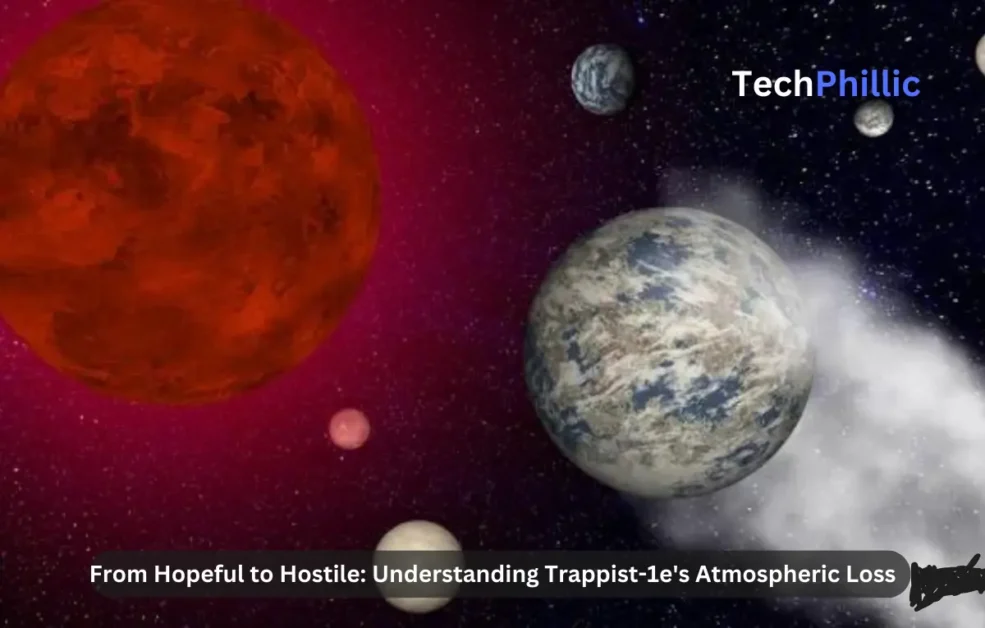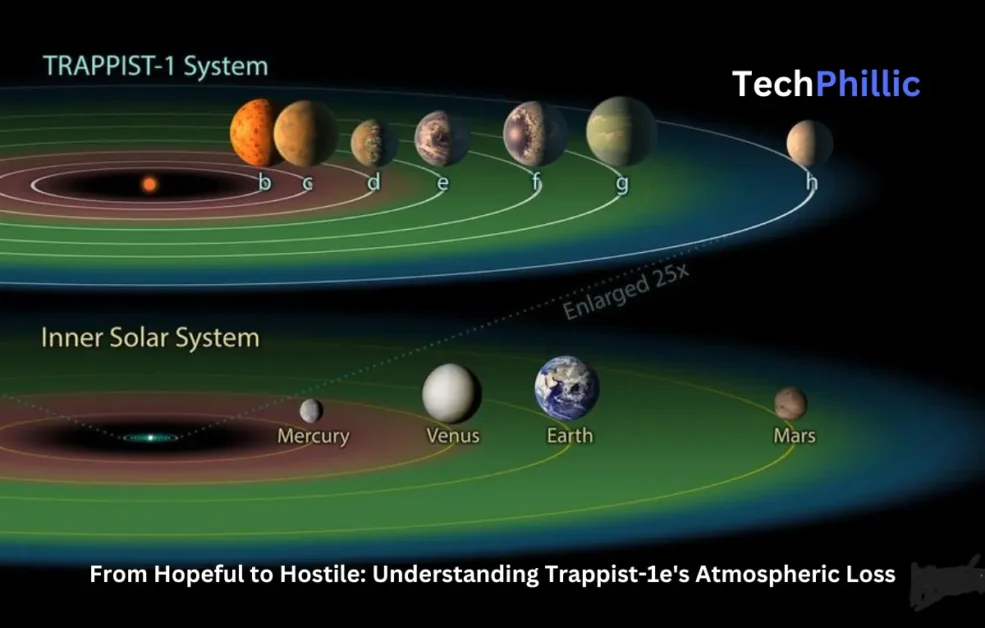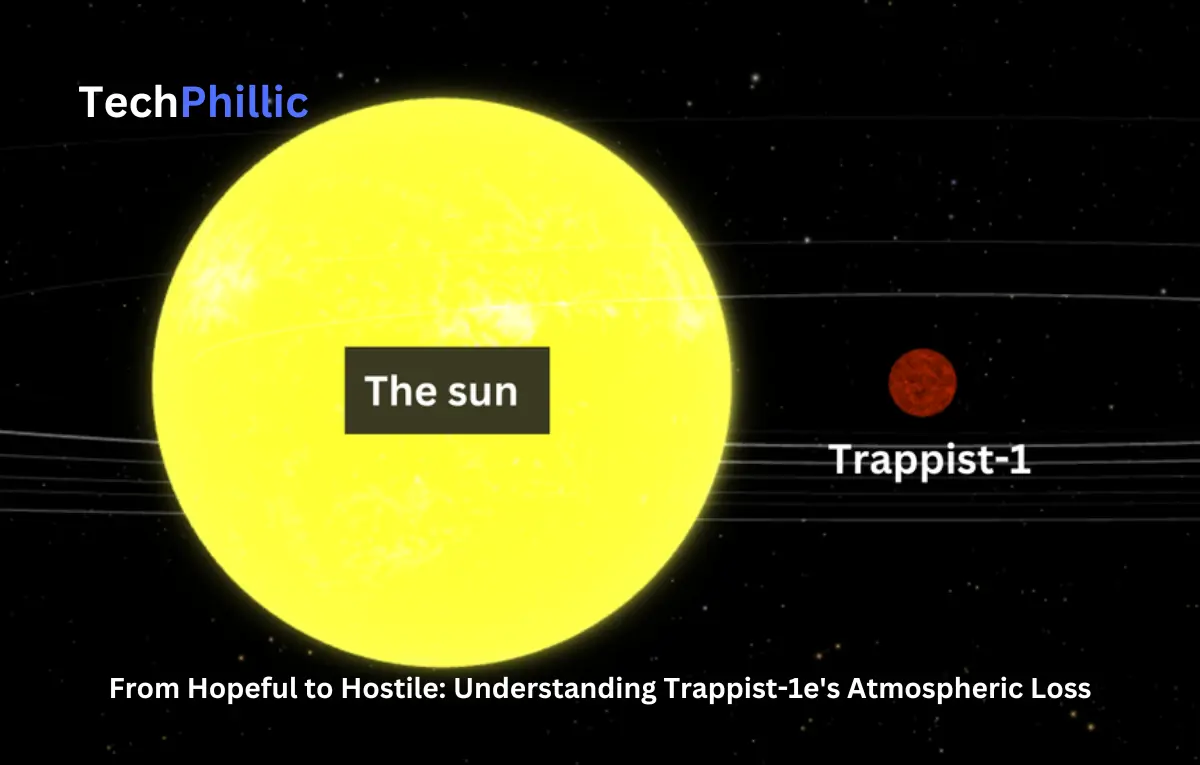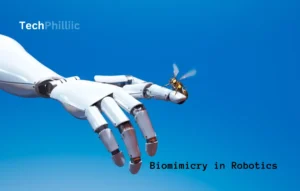Researchers have found that the planet Trappist-1e, which may one day be habitable, is losing its atmosphere. This discovery could make the planet uninhabitable for life. Electric currents generated when the planet revolves around its red dwarf host star appear to be the origin of the stripping.
This exoplanet, which orbits a tiny red dwarf star in the Trappist-1 system, has been one of the main targets in the search for extraterrestrial life, therefore its discovery is noteworthy. At least three of the system’s seven rocky Earth-like worlds are situated in the habitable zone, which is the area around a star that is just right for a planet to sustain liquid water without being too hot or too cold.
It is not possible for a planet without an atmosphere to retain liquid water, even if it is located in the habitable zone, sometimes referred to as the “Goldilocks zone.” This indicates that, while Trappist-1e might be in the 40 light-year-distance habitable zone of the red dwarf Trappist-1, its habitability might be ephemeral.
The bad news for the chances of discovering life in this system is that the same phenomena altering the atmosphere of Trappist-1e may also be influencing the atmospheres of the other planets in this habitable zone.
Ways to strip an exoplanet’s atmosphere
Despite being around the size of Earth, Trappist-1e has about 0.7 times the mass of our planet. It orbits at a mere 0.028 times the distance from Earth to the sun, taking only 6.1 Earth days to complete one circuit. It is the fourth planet from its star.
Despite this closeness, Trappist-1’s habitable zone is significantly closer to its surface than our star’s because it is smaller and colder than the sun. Consequently, the “stellar wind,” a jet of charged particles blasted from the star, appears to be removing the TRAPPIST-1e’s atmosphere rather than radiation from this red dwarf.
Astrophysicist Cecilia Garraffo of Harvard & Smithsonian said, “We looked at how the space weather changes through the planet’s orbit, with TRAPPIST-1e transitioning very rapidly between very different stellar wind conditions and pressures, leading to a sort of pulsing compression and relaxation of the planetary magnetic field.” “This drives strong electric currents in the upper atmosphere — the ionosphere — that heat up the atmosphere just like an electric heater.”

According to Garraffo, changes in the solar wind on Earth likewise result in a comparable heating of our atmosphere. The temperature that TRAPPIST-1e feels is different; it can be up to 100,000 times stronger than the solar winds that Earth receives from the sun. This is due to Trappist-1e’s rapid orbital motion around its star, which generates strong ionospheric currents that disperse and produce intense heating—a phenomenon the scientists refer to as “voltage-driven Joule heating.”
Although the researchers had anticipated this impact in 2017, they were taken aback by how potent they now discovered it to be.
“It could be so strong for TRAPPIST-1e that the heat essentially evaporates the upper atmosphere,” stated Garraffo. “Over millions of years, the planet could lose its atmosphere entirely to this phenomenon.”
The team’s research shows there are more than a couple of ways for a planet to lose its atmosphere.
According to Space.com, team member and researcher at the Lowell Center for Space Science & Technology Ofer Cohen, the loss of exoplanet atmospheres is usually thought to be caused by an outside force. This includes intense star radiation, which has the potential to heat up and flee the atmosphere, or charged particles striking planets in the stellar wind, which has a powerful stripping effect.
Here, only the planetary motion’s rapidity is responsible for the atmosphere’s heating and subsequent loss. According to Cohen, the planet merely moves around, dooming itself to lose its atmosphere. In the Boston area, at least, this is similar to the situation when we are too lazy to clear the snow off the roof of our car and instead just drive away, trusting that the air movement towing the car will do the dirty work for us.
“I think that it is very cool that planets can do this with their atmosphere.”
Also Read: Night City Gets a Makeover: Cyberpunk 2077 Patch 2.12 Delivers a Stream of Fixes and Enhancements
What about the other Trappist-1 planets?
By directing charged particles away from our planet and out behind it along magnetic field lines, the magnetosphere of Earth shields the atmosphere from harm. Mars’s atmosphere has been destroyed by solar winds and intense solar radiation since the planet lacks a strong magnetic field. Actually, this most likely resulted in the Red Planet losing its water to space.
Although a magnetosphere is thought to exist on Trappist-1e as well, these results suggest it might not be enough to stop atmospheric stripping.
“A planet’s magnetic field normally creates a protective bubble, but TRAPPIST-1e’s magnetic field compromises this bubble. The magnetic fields of the planet and the star interact, opening up channels that let the star’s particles strike the planet straight.” Garraffo said. “This not only strips away the atmosphere but also heats it up significantly, leaving TRAPPIST-1e and its neighbors vulnerable to losing their atmospheres entirely.”

The fourth planet from the red dwarf star at the center of this intriguing rocky world planetary system is called Trappist-1e. The nearest exoplanet to the star, Trappist-1b, appears to have already shed its atmosphere, according to earlier discoveries made by astronomers.
The researchers thinks voltage-driven Joule heating may also be hurting Trappist-1f and Trappist-1g, robbing them of their atmospheres, though not as much as it does for Trappist-1e. This is because these planets are traveling through the red dwarf’s stellar winds more slowly than Trappist-1e, at 0.038 and 0.04683 times the separation between Earth and the sun from their star, respectively.
“Closer-in planets of Trappist-1 will have an even more extreme fate, and further out ones a bit milder,” Garraffo stated. “I would imagine that all Trappist-1 planets are going to have a hard time holding on to any atmosphere.”
The results of the team’s investigation may have consequences not only for the Trappist-1 system but also for the hunt for extrasolar life and habitable exoplanets. Even though they are well within the star’s habitable zone, they imply that exoplanets near their stars have probably lost their atmospheres.
The findings may also aid in determining which stars might be home to planets that have chemicals indicative of life: biomarkers.
“According to Garraffo, “Our research indicates that these low-mass host stars are probably not the most promising for hosting planets with atmospheres.” Using the James Webb Space Telescope and other future observatories to detect atmospheric transits and identify which host stars may be favorable for habitable planets, as well as developing the technology to interpret those results in terms of biomarkers.”







